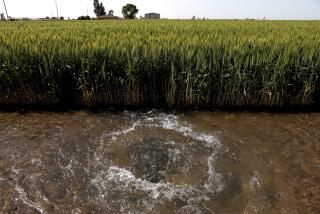New EPA Office Formed to Protect U.S. Wetlands
- Share via
Alarmed by the loss of more than half of the nation’s wetlands to development and agriculture, the U.S. Environmental Protection Agency on Monday announced the formation of an Office of Wetlands Protection and called for a national effort to turn the tide before the remaining marshes, swamps and bogs disappear.
EPA officials said that wetlands are decreasing at a “staggering” rate of nearly 300,000 acres a year. They said the loss of wetlands is not only threatening the habitat for wildlife and water fowl, but eliminating a resource that helps control flooding and filters pollution before it reaches lakes, streams, rivers and estuaries.
“Our desire as a nation for progress and convenience has placed our wetlands resource in jeopardy,” Lawrence J. Jensen, EPA assistant administrator for water, told the 59th annual conference of the Water Pollution Control Federation, meeting at the Los Angeles Convention Center.
Stepped-Up Enforcement
Jensen said the new Office of Wetlands Protection would begin operations immediately, including stepped-up enforcement against those who illegally pollute the wetlands, expanded assistance to states in developing protection programs and intensified efforts to identify, protect and restore the most valuable and vulnerable wetlands.
At the same time, Jensen said the EPA plans to join with the nonprofit Conservation Foundation to hold public forums over the next 12 months to solicit the views of farmers, developers, environmentalists and state and local governments on a new wetlands protection strategy.
The EPA’s announcement comes amid growing concern in Congress and among environmentalists over what many see as an unrelenting drive to drain, dredge and develop the nation’s wetlands. Of 215 million acres of wetlands that once existed in the lower 48 states, 95 million acres remain. More than 90% of wetlands in California, for example, have been drained, filled or otherwise developed, according to state officials. These include controversial developments in San Diego and Orange counties.
Development Restraints
Some restraints on wetlands development already exist. The federal Clean Water Act, for example, requires developers and others to obtain a permit from the Army Corps of Engineers before dredging or filling wetlands. Last year, the U.S. Supreme Court upheld and broadened the Army’s authority to regulate wetlands development.
However, farming is exempted and most of the marshes, swamps and bogs that are lost each year have been drained and converted to grow crops.
More than 165,000 acres of bottomland in the Mississippi Valley are developed each year, chiefly by soybean farmers. Congress last year inserted a so-called “swampbuster” provision in the farm aid bill that denies federal subsidies to farmers who drain wetlands to grow crops. But because soybean subsidies are minimal or non-existent, the “swampbuster” language has little impact, John Meagher, the EPA’s aquatic resources division director, said Monday in a telephone interview from Washington.
More to Read
Sign up for Essential California
The most important California stories and recommendations in your inbox every morning.
You may occasionally receive promotional content from the Los Angeles Times.












